Project Management Report: Analysis of Brickson Construction Project
VerifiedAdded on 2020/12/04
|13
|3339
|185
Report
AI Summary
This report provides a comprehensive analysis of project management principles and practices using the example of Brickson Construction. It begins by outlining the four stages of a project lifecycle: initiation, planning, execution, and closure, detailing the activities and estimated timelines for each stage in a construction project involving the building of two-level houses. The report then identifies the various stakeholders involved in the project and their expectations, emphasizing the role of the project manager in ensuring project success, including planning, resource management, risk mitigation, and stakeholder communication. Furthermore, the report presents a project plan for a Project Management Improvement initiative, detailing the project's purpose, assumptions, resource allocation, schedule, and budget. The report concludes by describing two key project monitoring methods: PERT charts for visualizing task dependencies and timelines, and Gantt charts for easy project tracking and progress monitoring.

Project management
Level 3
Ahmad Tabraze
Level 3
Ahmad Tabraze
Paraphrase This Document
Need a fresh take? Get an instant paraphrase of this document with our AI Paraphraser
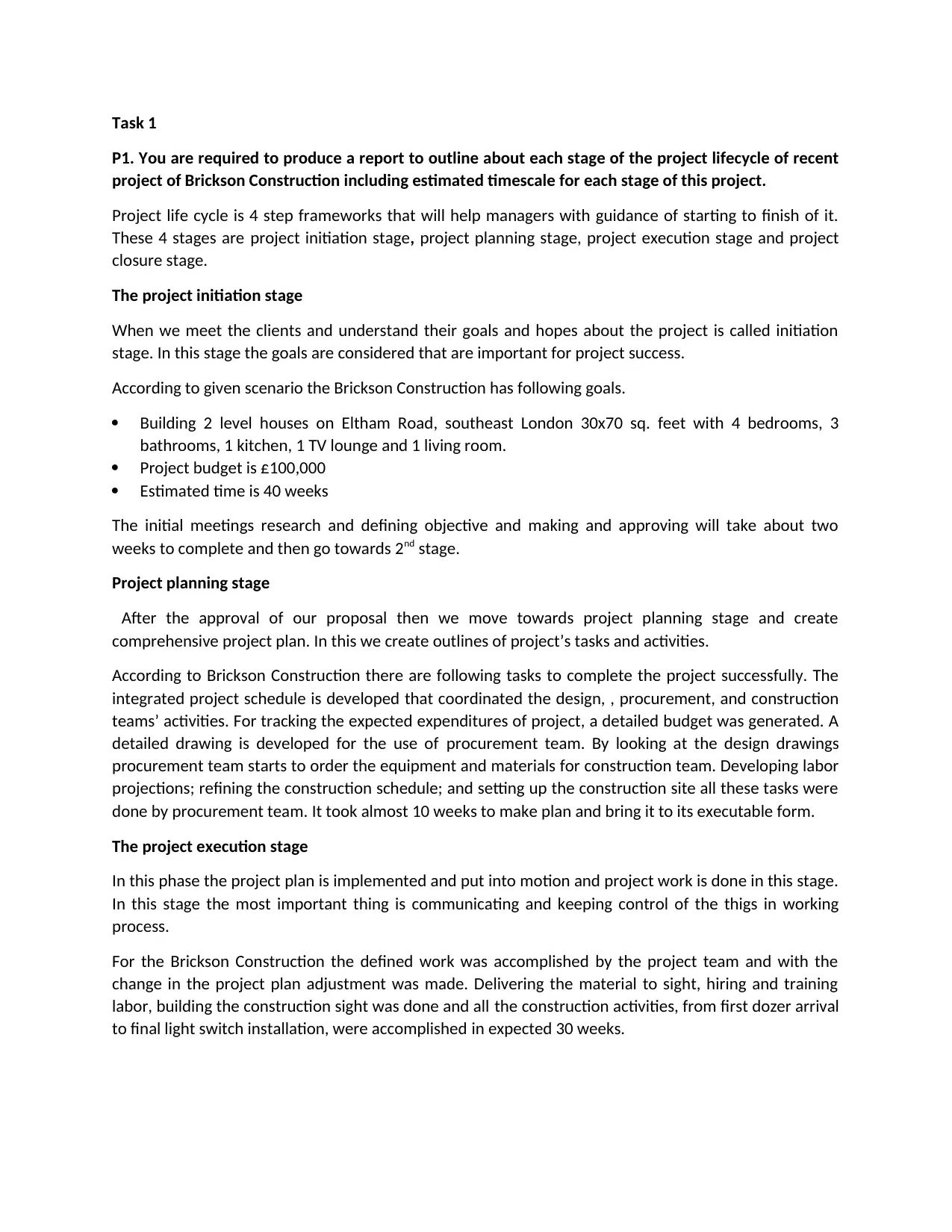
Task 1
P1. You are required to produce a report to outline about each stage of the project lifecycle of recent
project of Brickson Construction including estimated timescale for each stage of this project.
Project life cycle is 4 step frameworks that will help managers with guidance of starting to finish of it.
These 4 stages are project initiation stage, project planning stage, project execution stage and project
closure stage.
The project initiation stage
When we meet the clients and understand their goals and hopes about the project is called initiation
stage. In this stage the goals are considered that are important for project success.
According to given scenario the Brickson Construction has following goals.
Building 2 level houses on Eltham Road, southeast London 30x70 sq. feet with 4 bedrooms, 3
bathrooms, 1 kitchen, 1 TV lounge and 1 living room.
Project budget is £100,000
Estimated time is 40 weeks
The initial meetings research and defining objective and making and approving will take about two
weeks to complete and then go towards 2nd stage.
Project planning stage
After the approval of our proposal then we move towards project planning stage and create
comprehensive project plan. In this we create outlines of project’s tasks and activities.
According to Brickson Construction there are following tasks to complete the project successfully. The
integrated project schedule is developed that coordinated the design, , procurement, and construction
teams’ activities. For tracking the expected expenditures of project, a detailed budget was generated. A
detailed drawing is developed for the use of procurement team. By looking at the design drawings
procurement team starts to order the equipment and materials for construction team. Developing labor
projections; refining the construction schedule; and setting up the construction site all these tasks were
done by procurement team. It took almost 10 weeks to make plan and bring it to its executable form.
The project execution stage
In this phase the project plan is implemented and put into motion and project work is done in this stage.
In this stage the most important thing is communicating and keeping control of the thigs in working
process.
For the Brickson Construction the defined work was accomplished by the project team and with the
change in the project plan adjustment was made. Delivering the material to sight, hiring and training
labor, building the construction sight was done and all the construction activities, from first dozer arrival
to final light switch installation, were accomplished in expected 30 weeks.
P1. You are required to produce a report to outline about each stage of the project lifecycle of recent
project of Brickson Construction including estimated timescale for each stage of this project.
Project life cycle is 4 step frameworks that will help managers with guidance of starting to finish of it.
These 4 stages are project initiation stage, project planning stage, project execution stage and project
closure stage.
The project initiation stage
When we meet the clients and understand their goals and hopes about the project is called initiation
stage. In this stage the goals are considered that are important for project success.
According to given scenario the Brickson Construction has following goals.
Building 2 level houses on Eltham Road, southeast London 30x70 sq. feet with 4 bedrooms, 3
bathrooms, 1 kitchen, 1 TV lounge and 1 living room.
Project budget is £100,000
Estimated time is 40 weeks
The initial meetings research and defining objective and making and approving will take about two
weeks to complete and then go towards 2nd stage.
Project planning stage
After the approval of our proposal then we move towards project planning stage and create
comprehensive project plan. In this we create outlines of project’s tasks and activities.
According to Brickson Construction there are following tasks to complete the project successfully. The
integrated project schedule is developed that coordinated the design, , procurement, and construction
teams’ activities. For tracking the expected expenditures of project, a detailed budget was generated. A
detailed drawing is developed for the use of procurement team. By looking at the design drawings
procurement team starts to order the equipment and materials for construction team. Developing labor
projections; refining the construction schedule; and setting up the construction site all these tasks were
done by procurement team. It took almost 10 weeks to make plan and bring it to its executable form.
The project execution stage
In this phase the project plan is implemented and put into motion and project work is done in this stage.
In this stage the most important thing is communicating and keeping control of the thigs in working
process.
For the Brickson Construction the defined work was accomplished by the project team and with the
change in the project plan adjustment was made. Delivering the material to sight, hiring and training
labor, building the construction sight was done and all the construction activities, from first dozer arrival
to final light switch installation, were accomplished in expected 30 weeks.
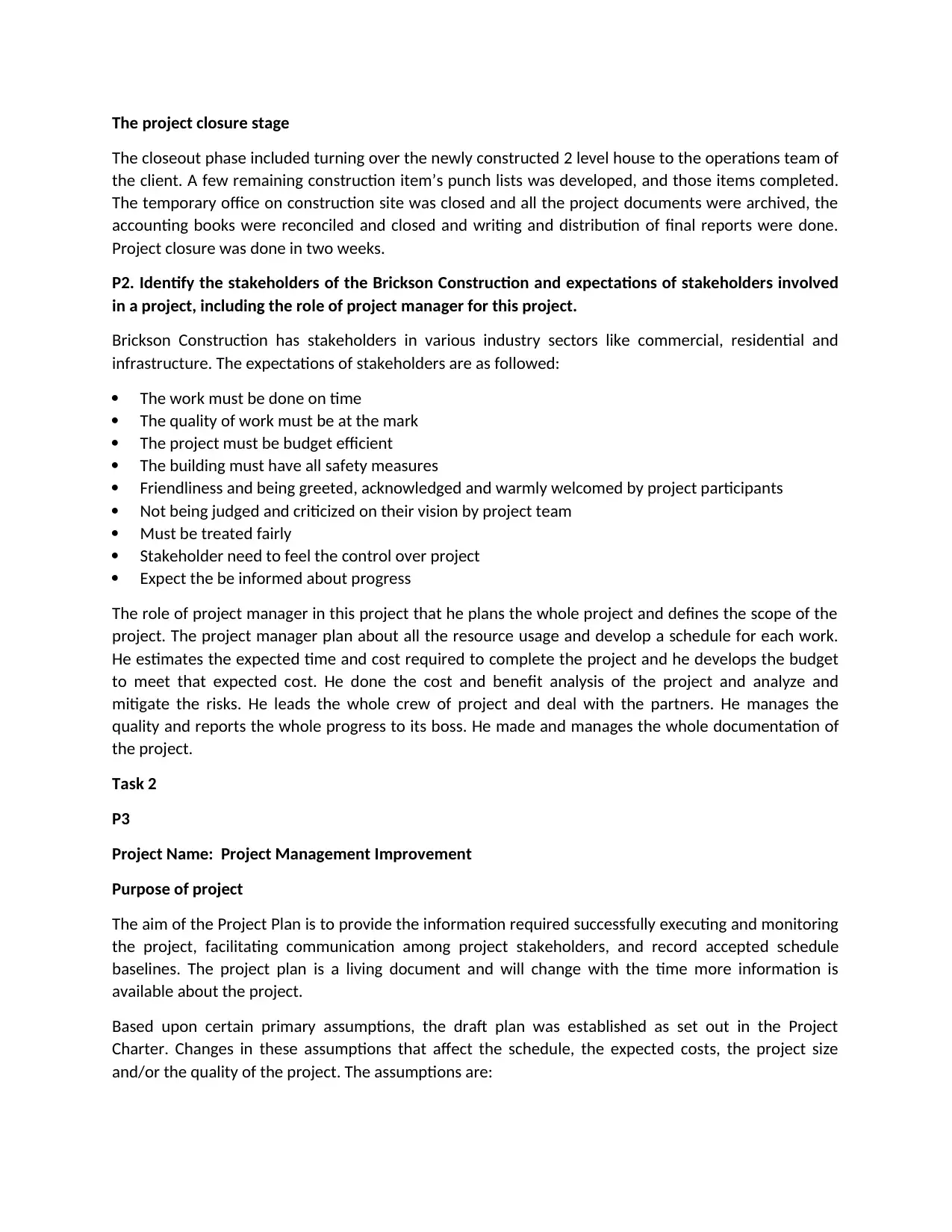
The project closure stage
The closeout phase included turning over the newly constructed 2 level house to the operations team of
the client. A few remaining construction item’s punch lists was developed, and those items completed.
The temporary office on construction site was closed and all the project documents were archived, the
accounting books were reconciled and closed and writing and distribution of final reports were done.
Project closure was done in two weeks.
P2. Identify the stakeholders of the Brickson Construction and expectations of stakeholders involved
in a project, including the role of project manager for this project.
Brickson Construction has stakeholders in various industry sectors like commercial, residential and
infrastructure. The expectations of stakeholders are as followed:
The work must be done on time
The quality of work must be at the mark
The project must be budget efficient
The building must have all safety measures
Friendliness and being greeted, acknowledged and warmly welcomed by project participants
Not being judged and criticized on their vision by project team
Must be treated fairly
Stakeholder need to feel the control over project
Expect the be informed about progress
The role of project manager in this project that he plans the whole project and defines the scope of the
project. The project manager plan about all the resource usage and develop a schedule for each work.
He estimates the expected time and cost required to complete the project and he develops the budget
to meet that expected cost. He done the cost and benefit analysis of the project and analyze and
mitigate the risks. He leads the whole crew of project and deal with the partners. He manages the
quality and reports the whole progress to its boss. He made and manages the whole documentation of
the project.
Task 2
P3
Project Name: Project Management Improvement
Purpose of project
The aim of the Project Plan is to provide the information required successfully executing and monitoring
the project, facilitating communication among project stakeholders, and record accepted schedule
baselines. The project plan is a living document and will change with the time more information is
available about the project.
Based upon certain primary assumptions, the draft plan was established as set out in the Project
Charter. Changes in these assumptions that affect the schedule, the expected costs, the project size
and/or the quality of the project. The assumptions are:
The closeout phase included turning over the newly constructed 2 level house to the operations team of
the client. A few remaining construction item’s punch lists was developed, and those items completed.
The temporary office on construction site was closed and all the project documents were archived, the
accounting books were reconciled and closed and writing and distribution of final reports were done.
Project closure was done in two weeks.
P2. Identify the stakeholders of the Brickson Construction and expectations of stakeholders involved
in a project, including the role of project manager for this project.
Brickson Construction has stakeholders in various industry sectors like commercial, residential and
infrastructure. The expectations of stakeholders are as followed:
The work must be done on time
The quality of work must be at the mark
The project must be budget efficient
The building must have all safety measures
Friendliness and being greeted, acknowledged and warmly welcomed by project participants
Not being judged and criticized on their vision by project team
Must be treated fairly
Stakeholder need to feel the control over project
Expect the be informed about progress
The role of project manager in this project that he plans the whole project and defines the scope of the
project. The project manager plan about all the resource usage and develop a schedule for each work.
He estimates the expected time and cost required to complete the project and he develops the budget
to meet that expected cost. He done the cost and benefit analysis of the project and analyze and
mitigate the risks. He leads the whole crew of project and deal with the partners. He manages the
quality and reports the whole progress to its boss. He made and manages the whole documentation of
the project.
Task 2
P3
Project Name: Project Management Improvement
Purpose of project
The aim of the Project Plan is to provide the information required successfully executing and monitoring
the project, facilitating communication among project stakeholders, and record accepted schedule
baselines. The project plan is a living document and will change with the time more information is
available about the project.
Based upon certain primary assumptions, the draft plan was established as set out in the Project
Charter. Changes in these assumptions that affect the schedule, the expected costs, the project size
and/or the quality of the project. The assumptions are:
⊘ This is a preview!⊘
Do you want full access?
Subscribe today to unlock all pages.

Trusted by 1+ million students worldwide
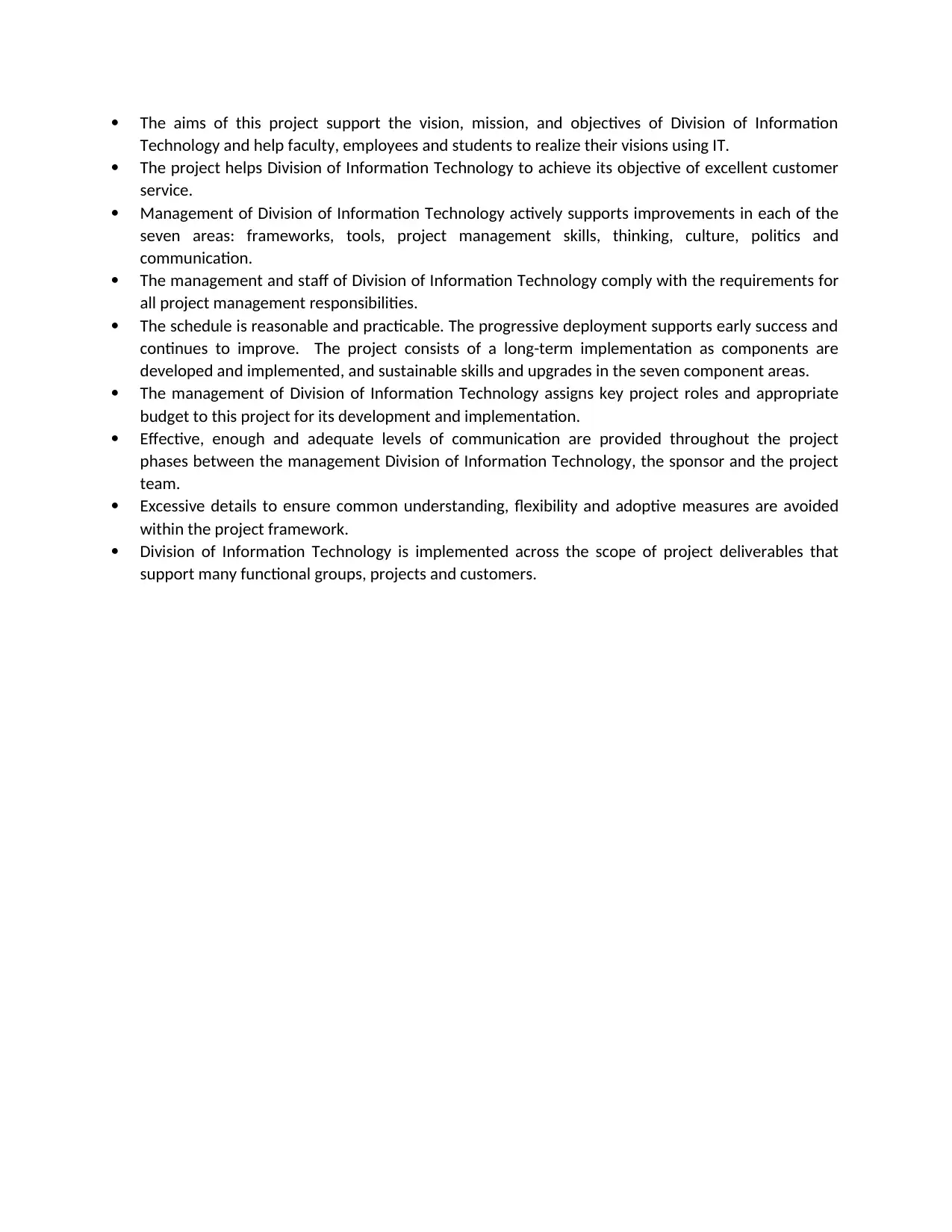
The aims of this project support the vision, mission, and objectives of Division of Information
Technology and help faculty, employees and students to realize their visions using IT.
The project helps Division of Information Technology to achieve its objective of excellent customer
service.
Management of Division of Information Technology actively supports improvements in each of the
seven areas: frameworks, tools, project management skills, thinking, culture, politics and
communication.
The management and staff of Division of Information Technology comply with the requirements for
all project management responsibilities.
The schedule is reasonable and practicable. The progressive deployment supports early success and
continues to improve. The project consists of a long-term implementation as components are
developed and implemented, and sustainable skills and upgrades in the seven component areas.
The management of Division of Information Technology assigns key project roles and appropriate
budget to this project for its development and implementation.
Effective, enough and adequate levels of communication are provided throughout the project
phases between the management Division of Information Technology, the sponsor and the project
team.
Excessive details to ensure common understanding, flexibility and adoptive measures are avoided
within the project framework.
Division of Information Technology is implemented across the scope of project deliverables that
support many functional groups, projects and customers.
Technology and help faculty, employees and students to realize their visions using IT.
The project helps Division of Information Technology to achieve its objective of excellent customer
service.
Management of Division of Information Technology actively supports improvements in each of the
seven areas: frameworks, tools, project management skills, thinking, culture, politics and
communication.
The management and staff of Division of Information Technology comply with the requirements for
all project management responsibilities.
The schedule is reasonable and practicable. The progressive deployment supports early success and
continues to improve. The project consists of a long-term implementation as components are
developed and implemented, and sustainable skills and upgrades in the seven component areas.
The management of Division of Information Technology assigns key project roles and appropriate
budget to this project for its development and implementation.
Effective, enough and adequate levels of communication are provided throughout the project
phases between the management Division of Information Technology, the sponsor and the project
team.
Excessive details to ensure common understanding, flexibility and adoptive measures are avoided
within the project framework.
Division of Information Technology is implemented across the scope of project deliverables that
support many functional groups, projects and customers.
Paraphrase This Document
Need a fresh take? Get an instant paraphrase of this document with our AI Paraphraser
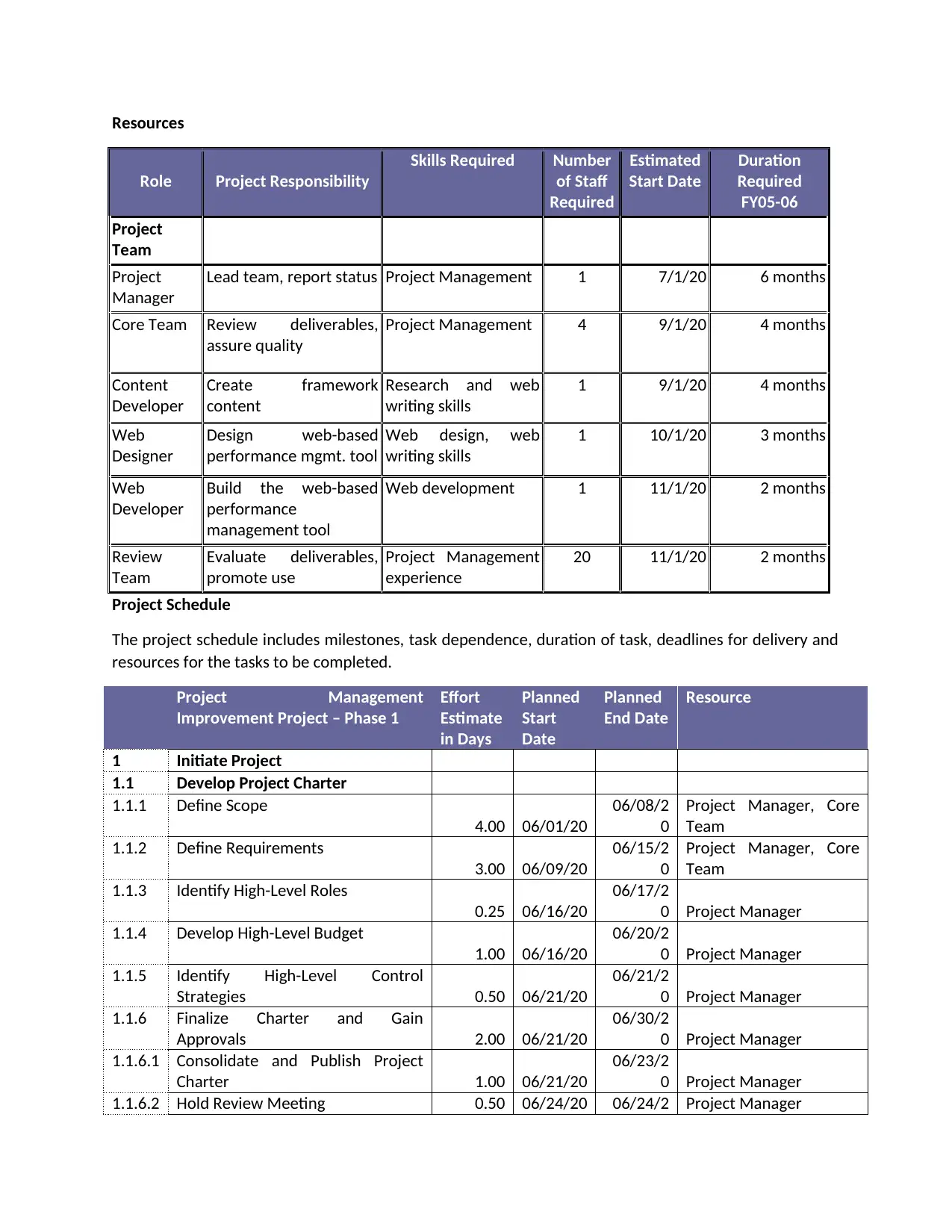
Resources
Role Project Responsibility
Skills Required Number
of Staff
Required
Estimated
Start Date
Duration
Required
FY05-06
Project
Team
Project
Manager
Lead team, report status Project Management 1 7/1/20 6 months
Core Team Review deliverables,
assure quality
Project Management 4 9/1/20 4 months
Content
Developer
Create framework
content
Research and web
writing skills
1 9/1/20 4 months
Web
Designer
Design web-based
performance mgmt. tool
Web design, web
writing skills
1 10/1/20 3 months
Web
Developer
Build the web-based
performance
management tool
Web development 1 11/1/20 2 months
Review
Team
Evaluate deliverables,
promote use
Project Management
experience
20 11/1/20 2 months
Project Schedule
The project schedule includes milestones, task dependence, duration of task, deadlines for delivery and
resources for the tasks to be completed.
Project Management
Improvement Project – Phase 1
Effort
Estimate
in Days
Planned
Start
Date
Planned
End Date
Resource
1 Initiate Project
1.1 Develop Project Charter
1.1.1 Define Scope
4.00 06/01/20
06/08/2
0
Project Manager, Core
Team
1.1.2 Define Requirements
3.00 06/09/20
06/15/2
0
Project Manager, Core
Team
1.1.3 Identify High-Level Roles
0.25 06/16/20
06/17/2
0 Project Manager
1.1.4 Develop High-Level Budget
1.00 06/16/20
06/20/2
0 Project Manager
1.1.5 Identify High-Level Control
Strategies 0.50 06/21/20
06/21/2
0 Project Manager
1.1.6 Finalize Charter and Gain
Approvals 2.00 06/21/20
06/30/2
0 Project Manager
1.1.6.1 Consolidate and Publish Project
Charter 1.00 06/21/20
06/23/2
0 Project Manager
1.1.6.2 Hold Review Meeting 0.50 06/24/20 06/24/2 Project Manager
Role Project Responsibility
Skills Required Number
of Staff
Required
Estimated
Start Date
Duration
Required
FY05-06
Project
Team
Project
Manager
Lead team, report status Project Management 1 7/1/20 6 months
Core Team Review deliverables,
assure quality
Project Management 4 9/1/20 4 months
Content
Developer
Create framework
content
Research and web
writing skills
1 9/1/20 4 months
Web
Designer
Design web-based
performance mgmt. tool
Web design, web
writing skills
1 10/1/20 3 months
Web
Developer
Build the web-based
performance
management tool
Web development 1 11/1/20 2 months
Review
Team
Evaluate deliverables,
promote use
Project Management
experience
20 11/1/20 2 months
Project Schedule
The project schedule includes milestones, task dependence, duration of task, deadlines for delivery and
resources for the tasks to be completed.
Project Management
Improvement Project – Phase 1
Effort
Estimate
in Days
Planned
Start
Date
Planned
End Date
Resource
1 Initiate Project
1.1 Develop Project Charter
1.1.1 Define Scope
4.00 06/01/20
06/08/2
0
Project Manager, Core
Team
1.1.2 Define Requirements
3.00 06/09/20
06/15/2
0
Project Manager, Core
Team
1.1.3 Identify High-Level Roles
0.25 06/16/20
06/17/2
0 Project Manager
1.1.4 Develop High-Level Budget
1.00 06/16/20
06/20/2
0 Project Manager
1.1.5 Identify High-Level Control
Strategies 0.50 06/21/20
06/21/2
0 Project Manager
1.1.6 Finalize Charter and Gain
Approvals 2.00 06/21/20
06/30/2
0 Project Manager
1.1.6.1 Consolidate and Publish Project
Charter 1.00 06/21/20
06/23/2
0 Project Manager
1.1.6.2 Hold Review Meeting 0.50 06/24/20 06/24/2 Project Manager
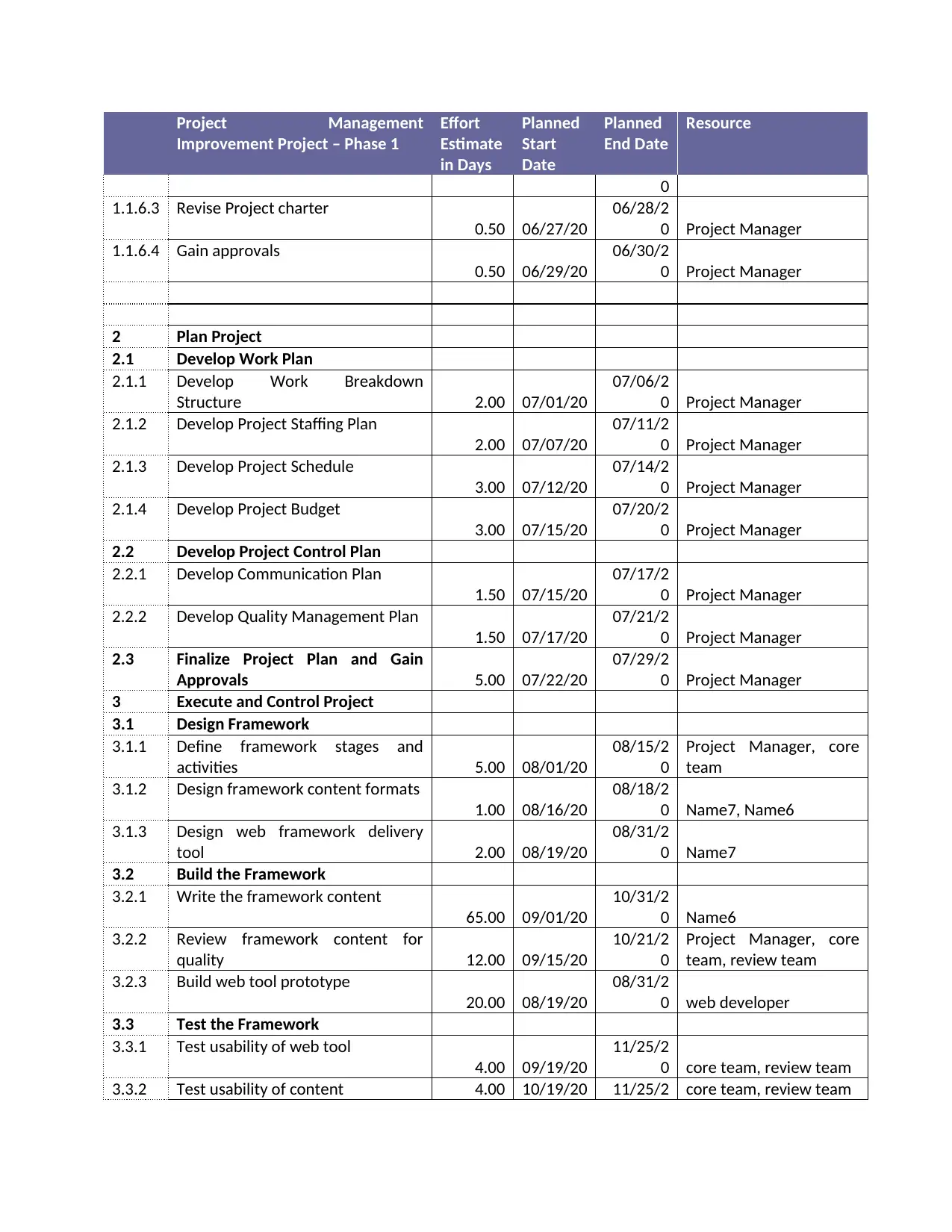
Project Management
Improvement Project – Phase 1
Effort
Estimate
in Days
Planned
Start
Date
Planned
End Date
Resource
0
1.1.6.3 Revise Project charter
0.50 06/27/20
06/28/2
0 Project Manager
1.1.6.4 Gain approvals
0.50 06/29/20
06/30/2
0 Project Manager
2 Plan Project
2.1 Develop Work Plan
2.1.1 Develop Work Breakdown
Structure 2.00 07/01/20
07/06/2
0 Project Manager
2.1.2 Develop Project Staffing Plan
2.00 07/07/20
07/11/2
0 Project Manager
2.1.3 Develop Project Schedule
3.00 07/12/20
07/14/2
0 Project Manager
2.1.4 Develop Project Budget
3.00 07/15/20
07/20/2
0 Project Manager
2.2 Develop Project Control Plan
2.2.1 Develop Communication Plan
1.50 07/15/20
07/17/2
0 Project Manager
2.2.2 Develop Quality Management Plan
1.50 07/17/20
07/21/2
0 Project Manager
2.3 Finalize Project Plan and Gain
Approvals 5.00 07/22/20
07/29/2
0 Project Manager
3 Execute and Control Project
3.1 Design Framework
3.1.1 Define framework stages and
activities 5.00 08/01/20
08/15/2
0
Project Manager, core
team
3.1.2 Design framework content formats
1.00 08/16/20
08/18/2
0 Name7, Name6
3.1.3 Design web framework delivery
tool 2.00 08/19/20
08/31/2
0 Name7
3.2 Build the Framework
3.2.1 Write the framework content
65.00 09/01/20
10/31/2
0 Name6
3.2.2 Review framework content for
quality 12.00 09/15/20
10/21/2
0
Project Manager, core
team, review team
3.2.3 Build web tool prototype
20.00 08/19/20
08/31/2
0 web developer
3.3 Test the Framework
3.3.1 Test usability of web tool
4.00 09/19/20
11/25/2
0 core team, review team
3.3.2 Test usability of content 4.00 10/19/20 11/25/2 core team, review team
Improvement Project – Phase 1
Effort
Estimate
in Days
Planned
Start
Date
Planned
End Date
Resource
0
1.1.6.3 Revise Project charter
0.50 06/27/20
06/28/2
0 Project Manager
1.1.6.4 Gain approvals
0.50 06/29/20
06/30/2
0 Project Manager
2 Plan Project
2.1 Develop Work Plan
2.1.1 Develop Work Breakdown
Structure 2.00 07/01/20
07/06/2
0 Project Manager
2.1.2 Develop Project Staffing Plan
2.00 07/07/20
07/11/2
0 Project Manager
2.1.3 Develop Project Schedule
3.00 07/12/20
07/14/2
0 Project Manager
2.1.4 Develop Project Budget
3.00 07/15/20
07/20/2
0 Project Manager
2.2 Develop Project Control Plan
2.2.1 Develop Communication Plan
1.50 07/15/20
07/17/2
0 Project Manager
2.2.2 Develop Quality Management Plan
1.50 07/17/20
07/21/2
0 Project Manager
2.3 Finalize Project Plan and Gain
Approvals 5.00 07/22/20
07/29/2
0 Project Manager
3 Execute and Control Project
3.1 Design Framework
3.1.1 Define framework stages and
activities 5.00 08/01/20
08/15/2
0
Project Manager, core
team
3.1.2 Design framework content formats
1.00 08/16/20
08/18/2
0 Name7, Name6
3.1.3 Design web framework delivery
tool 2.00 08/19/20
08/31/2
0 Name7
3.2 Build the Framework
3.2.1 Write the framework content
65.00 09/01/20
10/31/2
0 Name6
3.2.2 Review framework content for
quality 12.00 09/15/20
10/21/2
0
Project Manager, core
team, review team
3.2.3 Build web tool prototype
20.00 08/19/20
08/31/2
0 web developer
3.3 Test the Framework
3.3.1 Test usability of web tool
4.00 09/19/20
11/25/2
0 core team, review team
3.3.2 Test usability of content 4.00 10/19/20 11/25/2 core team, review team
⊘ This is a preview!⊘
Do you want full access?
Subscribe today to unlock all pages.

Trusted by 1+ million students worldwide
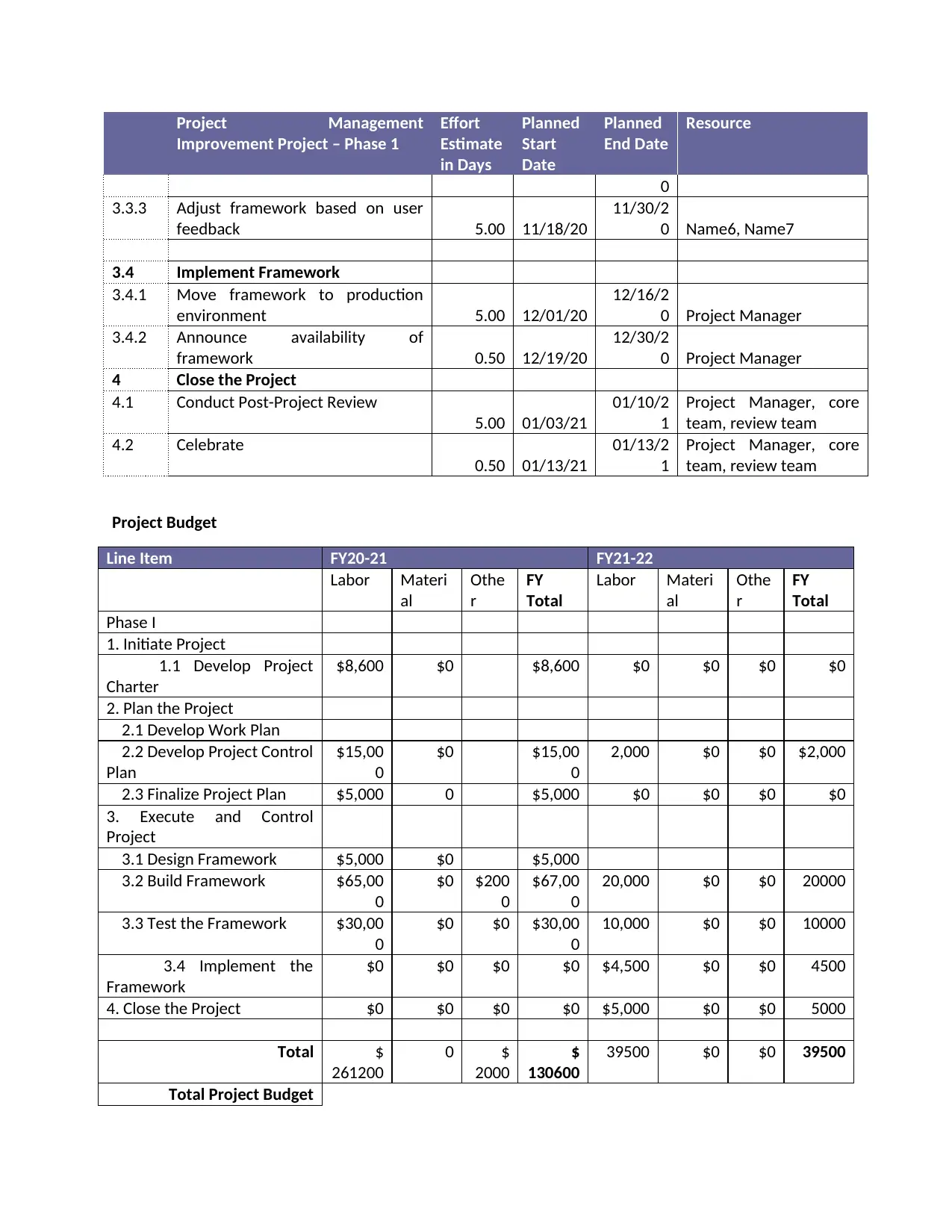
Project Management
Improvement Project – Phase 1
Effort
Estimate
in Days
Planned
Start
Date
Planned
End Date
Resource
0
3.3.3 Adjust framework based on user
feedback 5.00 11/18/20
11/30/2
0 Name6, Name7
3.4 Implement Framework
3.4.1 Move framework to production
environment 5.00 12/01/20
12/16/2
0 Project Manager
3.4.2 Announce availability of
framework 0.50 12/19/20
12/30/2
0 Project Manager
4 Close the Project
4.1 Conduct Post-Project Review
5.00 01/03/21
01/10/2
1
Project Manager, core
team, review team
4.2 Celebrate
0.50 01/13/21
01/13/2
1
Project Manager, core
team, review team
Project Budget
Line Item FY20-21 FY21-22
Labor Materi
al
Othe
r
FY
Total
Labor Materi
al
Othe
r
FY
Total
Phase I
1. Initiate Project
1.1 Develop Project
Charter
$8,600 $0 $8,600 $0 $0 $0 $0
2. Plan the Project
2.1 Develop Work Plan
2.2 Develop Project Control
Plan
$15,00
0
$0 $15,00
0
2,000 $0 $0 $2,000
2.3 Finalize Project Plan $5,000 0 $5,000 $0 $0 $0 $0
3. Execute and Control
Project
3.1 Design Framework $5,000 $0 $5,000
3.2 Build Framework $65,00
0
$0 $200
0
$67,00
0
20,000 $0 $0 20000
3.3 Test the Framework $30,00
0
$0 $0 $30,00
0
10,000 $0 $0 10000
3.4 Implement the
Framework
$0 $0 $0 $0 $4,500 $0 $0 4500
4. Close the Project $0 $0 $0 $0 $5,000 $0 $0 5000
Total $
261200
0 $
2000
$
130600
39500 $0 $0 39500
Total Project Budget
Improvement Project – Phase 1
Effort
Estimate
in Days
Planned
Start
Date
Planned
End Date
Resource
0
3.3.3 Adjust framework based on user
feedback 5.00 11/18/20
11/30/2
0 Name6, Name7
3.4 Implement Framework
3.4.1 Move framework to production
environment 5.00 12/01/20
12/16/2
0 Project Manager
3.4.2 Announce availability of
framework 0.50 12/19/20
12/30/2
0 Project Manager
4 Close the Project
4.1 Conduct Post-Project Review
5.00 01/03/21
01/10/2
1
Project Manager, core
team, review team
4.2 Celebrate
0.50 01/13/21
01/13/2
1
Project Manager, core
team, review team
Project Budget
Line Item FY20-21 FY21-22
Labor Materi
al
Othe
r
FY
Total
Labor Materi
al
Othe
r
FY
Total
Phase I
1. Initiate Project
1.1 Develop Project
Charter
$8,600 $0 $8,600 $0 $0 $0 $0
2. Plan the Project
2.1 Develop Work Plan
2.2 Develop Project Control
Plan
$15,00
0
$0 $15,00
0
2,000 $0 $0 $2,000
2.3 Finalize Project Plan $5,000 0 $5,000 $0 $0 $0 $0
3. Execute and Control
Project
3.1 Design Framework $5,000 $0 $5,000
3.2 Build Framework $65,00
0
$0 $200
0
$67,00
0
20,000 $0 $0 20000
3.3 Test the Framework $30,00
0
$0 $0 $30,00
0
10,000 $0 $0 10000
3.4 Implement the
Framework
$0 $0 $0 $0 $4,500 $0 $0 4500
4. Close the Project $0 $0 $0 $0 $5,000 $0 $0 5000
Total $
261200
0 $
2000
$
130600
39500 $0 $0 39500
Total Project Budget
Paraphrase This Document
Need a fresh take? Get an instant paraphrase of this document with our AI Paraphraser
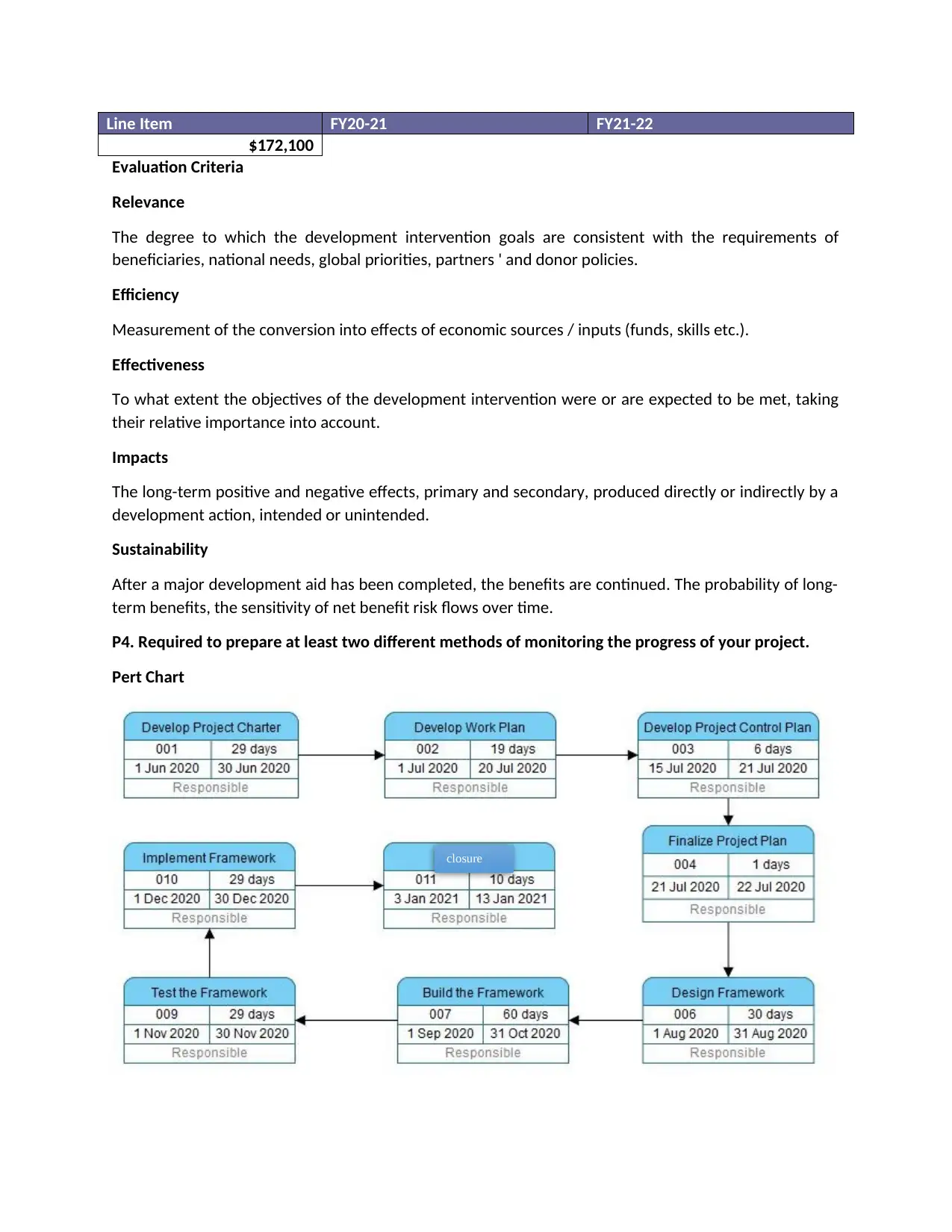
Line Item FY20-21 FY21-22
$172,100
Evaluation Criteria
Relevance
The degree to which the development intervention goals are consistent with the requirements of
beneficiaries, national needs, global priorities, partners ' and donor policies.
Efficiency
Measurement of the conversion into effects of economic sources / inputs (funds, skills etc.).
Effectiveness
To what extent the objectives of the development intervention were or are expected to be met, taking
their relative importance into account.
Impacts
The long-term positive and negative effects, primary and secondary, produced directly or indirectly by a
development action, intended or unintended.
Sustainability
After a major development aid has been completed, the benefits are continued. The probability of long-
term benefits, the sensitivity of net benefit risk flows over time.
P4. Required to prepare at least two different methods of monitoring the progress of your project.
Pert Chart
closure
$172,100
Evaluation Criteria
Relevance
The degree to which the development intervention goals are consistent with the requirements of
beneficiaries, national needs, global priorities, partners ' and donor policies.
Efficiency
Measurement of the conversion into effects of economic sources / inputs (funds, skills etc.).
Effectiveness
To what extent the objectives of the development intervention were or are expected to be met, taking
their relative importance into account.
Impacts
The long-term positive and negative effects, primary and secondary, produced directly or indirectly by a
development action, intended or unintended.
Sustainability
After a major development aid has been completed, the benefits are continued. The probability of long-
term benefits, the sensitivity of net benefit risk flows over time.
P4. Required to prepare at least two different methods of monitoring the progress of your project.
Pert Chart
closure
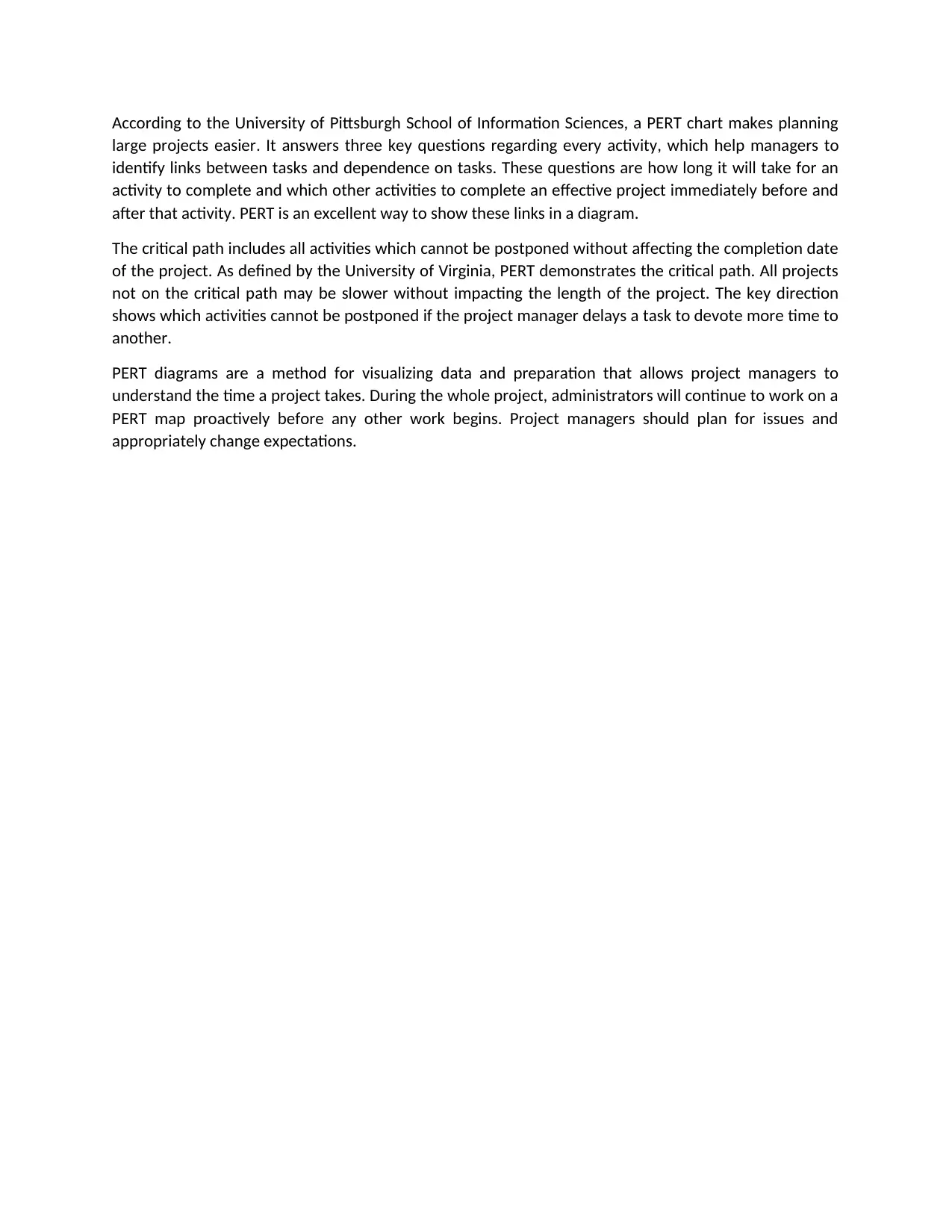
According to the University of Pittsburgh School of Information Sciences, a PERT chart makes planning
large projects easier. It answers three key questions regarding every activity, which help managers to
identify links between tasks and dependence on tasks. These questions are how long it will take for an
activity to complete and which other activities to complete an effective project immediately before and
after that activity. PERT is an excellent way to show these links in a diagram.
The critical path includes all activities which cannot be postponed without affecting the completion date
of the project. As defined by the University of Virginia, PERT demonstrates the critical path. All projects
not on the critical path may be slower without impacting the length of the project. The key direction
shows which activities cannot be postponed if the project manager delays a task to devote more time to
another.
PERT diagrams are a method for visualizing data and preparation that allows project managers to
understand the time a project takes. During the whole project, administrators will continue to work on a
PERT map proactively before any other work begins. Project managers should plan for issues and
appropriately change expectations.
large projects easier. It answers three key questions regarding every activity, which help managers to
identify links between tasks and dependence on tasks. These questions are how long it will take for an
activity to complete and which other activities to complete an effective project immediately before and
after that activity. PERT is an excellent way to show these links in a diagram.
The critical path includes all activities which cannot be postponed without affecting the completion date
of the project. As defined by the University of Virginia, PERT demonstrates the critical path. All projects
not on the critical path may be slower without impacting the length of the project. The key direction
shows which activities cannot be postponed if the project manager delays a task to devote more time to
another.
PERT diagrams are a method for visualizing data and preparation that allows project managers to
understand the time a project takes. During the whole project, administrators will continue to work on a
PERT map proactively before any other work begins. Project managers should plan for issues and
appropriately change expectations.
⊘ This is a preview!⊘
Do you want full access?
Subscribe today to unlock all pages.

Trusted by 1+ million students worldwide
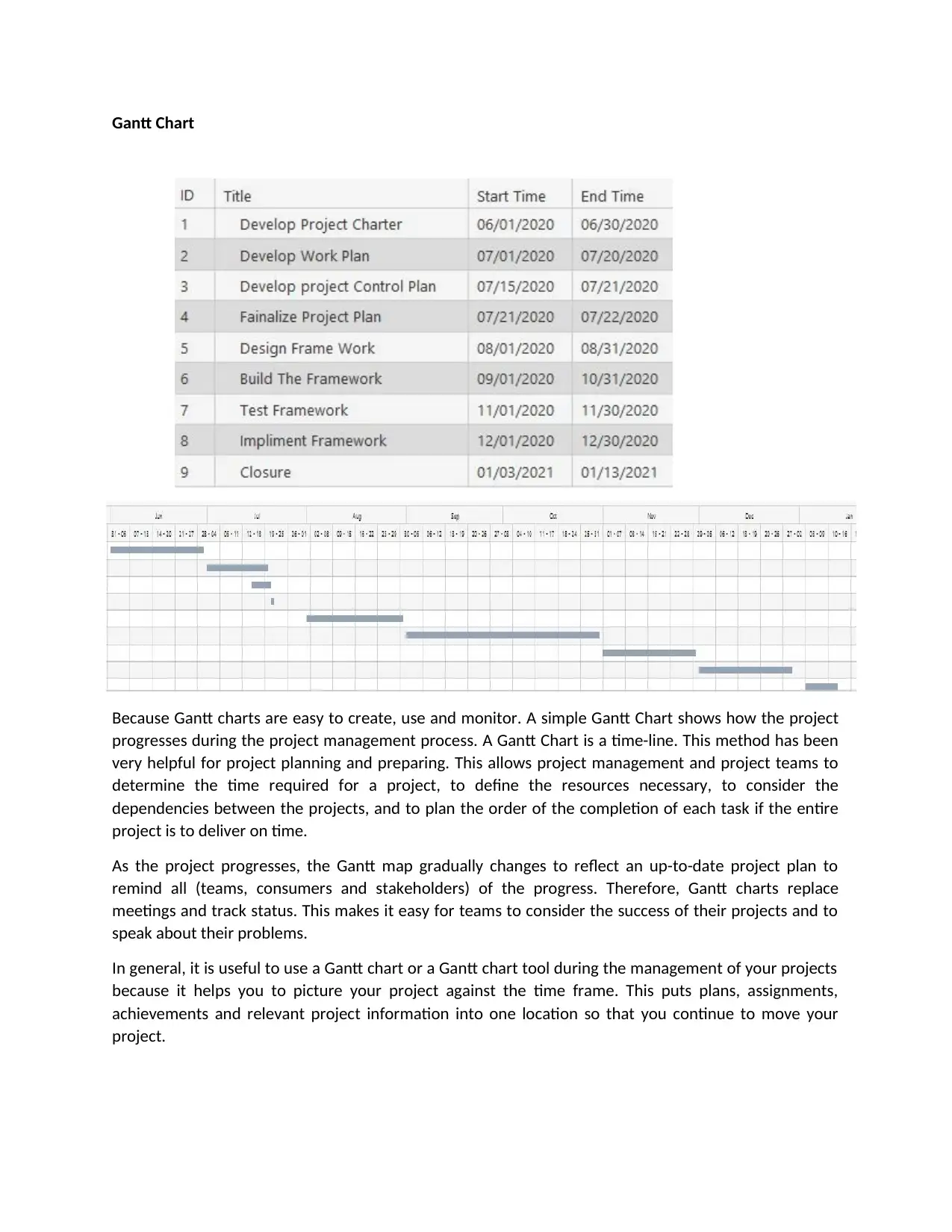
Gantt Chart
Because Gantt charts are easy to create, use and monitor. A simple Gantt Chart shows how the project
progresses during the project management process. A Gantt Chart is a time-line. This method has been
very helpful for project planning and preparing. This allows project management and project teams to
determine the time required for a project, to define the resources necessary, to consider the
dependencies between the projects, and to plan the order of the completion of each task if the entire
project is to deliver on time.
As the project progresses, the Gantt map gradually changes to reflect an up-to-date project plan to
remind all (teams, consumers and stakeholders) of the progress. Therefore, Gantt charts replace
meetings and track status. This makes it easy for teams to consider the success of their projects and to
speak about their problems.
In general, it is useful to use a Gantt chart or a Gantt chart tool during the management of your projects
because it helps you to picture your project against the time frame. This puts plans, assignments,
achievements and relevant project information into one location so that you continue to move your
project.
Because Gantt charts are easy to create, use and monitor. A simple Gantt Chart shows how the project
progresses during the project management process. A Gantt Chart is a time-line. This method has been
very helpful for project planning and preparing. This allows project management and project teams to
determine the time required for a project, to define the resources necessary, to consider the
dependencies between the projects, and to plan the order of the completion of each task if the entire
project is to deliver on time.
As the project progresses, the Gantt map gradually changes to reflect an up-to-date project plan to
remind all (teams, consumers and stakeholders) of the progress. Therefore, Gantt charts replace
meetings and track status. This makes it easy for teams to consider the success of their projects and to
speak about their problems.
In general, it is useful to use a Gantt chart or a Gantt chart tool during the management of your projects
because it helps you to picture your project against the time frame. This puts plans, assignments,
achievements and relevant project information into one location so that you continue to move your
project.
Paraphrase This Document
Need a fresh take? Get an instant paraphrase of this document with our AI Paraphraser
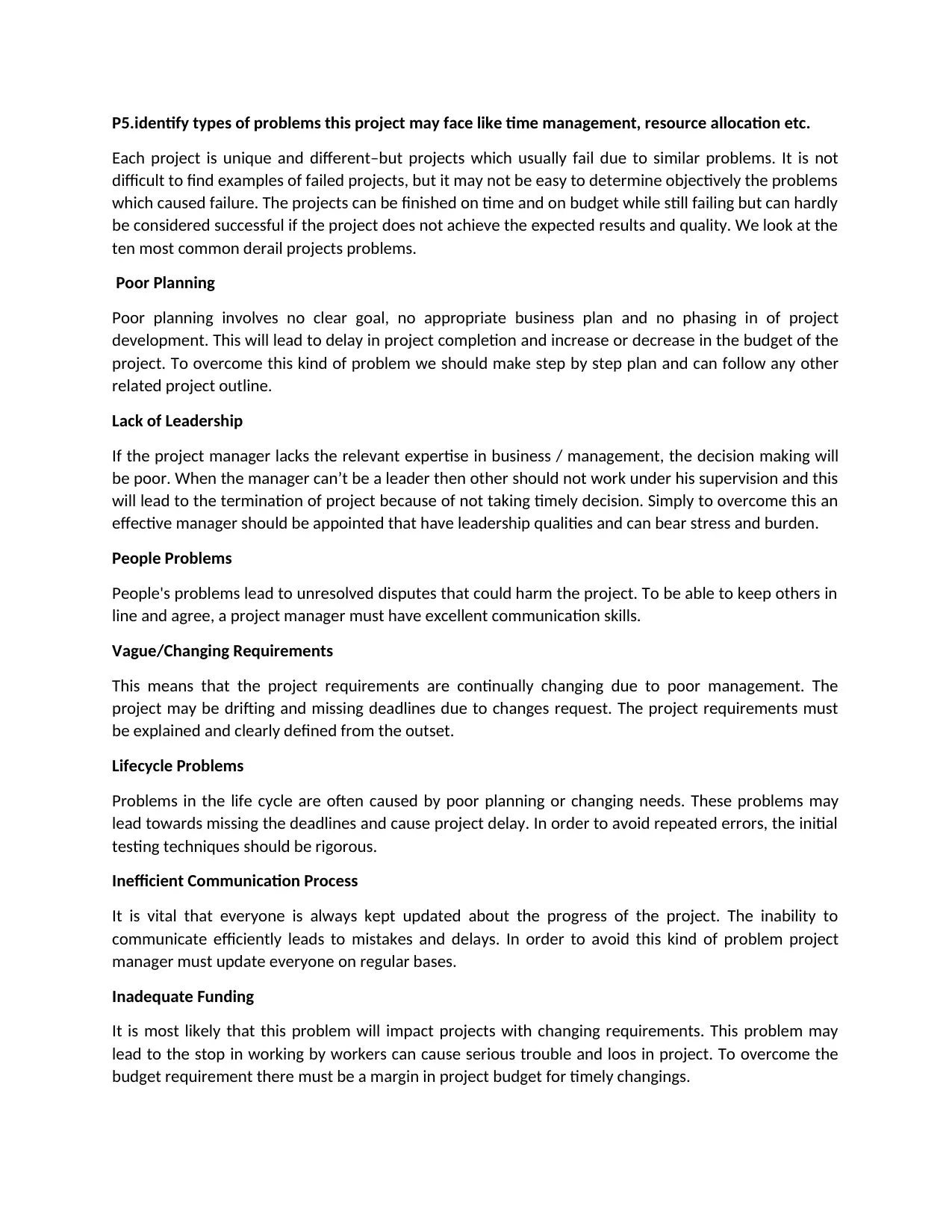
P5.identify types of problems this project may face like time management, resource allocation etc.
Each project is unique and different–but projects which usually fail due to similar problems. It is not
difficult to find examples of failed projects, but it may not be easy to determine objectively the problems
which caused failure. The projects can be finished on time and on budget while still failing but can hardly
be considered successful if the project does not achieve the expected results and quality. We look at the
ten most common derail projects problems.
Poor Planning
Poor planning involves no clear goal, no appropriate business plan and no phasing in of project
development. This will lead to delay in project completion and increase or decrease in the budget of the
project. To overcome this kind of problem we should make step by step plan and can follow any other
related project outline.
Lack of Leadership
If the project manager lacks the relevant expertise in business / management, the decision making will
be poor. When the manager can’t be a leader then other should not work under his supervision and this
will lead to the termination of project because of not taking timely decision. Simply to overcome this an
effective manager should be appointed that have leadership qualities and can bear stress and burden.
People Problems
People's problems lead to unresolved disputes that could harm the project. To be able to keep others in
line and agree, a project manager must have excellent communication skills.
Vague/Changing Requirements
This means that the project requirements are continually changing due to poor management. The
project may be drifting and missing deadlines due to changes request. The project requirements must
be explained and clearly defined from the outset.
Lifecycle Problems
Problems in the life cycle are often caused by poor planning or changing needs. These problems may
lead towards missing the deadlines and cause project delay. In order to avoid repeated errors, the initial
testing techniques should be rigorous.
Inefficient Communication Process
It is vital that everyone is always kept updated about the progress of the project. The inability to
communicate efficiently leads to mistakes and delays. In order to avoid this kind of problem project
manager must update everyone on regular bases.
Inadequate Funding
It is most likely that this problem will impact projects with changing requirements. This problem may
lead to the stop in working by workers can cause serious trouble and loos in project. To overcome the
budget requirement there must be a margin in project budget for timely changings.
Each project is unique and different–but projects which usually fail due to similar problems. It is not
difficult to find examples of failed projects, but it may not be easy to determine objectively the problems
which caused failure. The projects can be finished on time and on budget while still failing but can hardly
be considered successful if the project does not achieve the expected results and quality. We look at the
ten most common derail projects problems.
Poor Planning
Poor planning involves no clear goal, no appropriate business plan and no phasing in of project
development. This will lead to delay in project completion and increase or decrease in the budget of the
project. To overcome this kind of problem we should make step by step plan and can follow any other
related project outline.
Lack of Leadership
If the project manager lacks the relevant expertise in business / management, the decision making will
be poor. When the manager can’t be a leader then other should not work under his supervision and this
will lead to the termination of project because of not taking timely decision. Simply to overcome this an
effective manager should be appointed that have leadership qualities and can bear stress and burden.
People Problems
People's problems lead to unresolved disputes that could harm the project. To be able to keep others in
line and agree, a project manager must have excellent communication skills.
Vague/Changing Requirements
This means that the project requirements are continually changing due to poor management. The
project may be drifting and missing deadlines due to changes request. The project requirements must
be explained and clearly defined from the outset.
Lifecycle Problems
Problems in the life cycle are often caused by poor planning or changing needs. These problems may
lead towards missing the deadlines and cause project delay. In order to avoid repeated errors, the initial
testing techniques should be rigorous.
Inefficient Communication Process
It is vital that everyone is always kept updated about the progress of the project. The inability to
communicate efficiently leads to mistakes and delays. In order to avoid this kind of problem project
manager must update everyone on regular bases.
Inadequate Funding
It is most likely that this problem will impact projects with changing requirements. This problem may
lead to the stop in working by workers can cause serious trouble and loos in project. To overcome the
budget requirement there must be a margin in project budget for timely changings.

Stakeholder Approval
The other problem is stakeholder’s approval that will impact the project management. The ability to
identify individuals affected by the successful results of the project will be effective stakeholder
management. A skilled project manager shall ensure that there is a collaborative work environment in
which all stakeholders are able to analyze and discuss project phases, but the ability to identify people
affected / likely to affect a successful project outcome is an effective way.
Schedule absence
If there is no effective schedule given the time management can be issue that will leads toward missing
deadlines and cause delay in the project. To avoid this problem there should be a proper time schedule
with a margin of any uncertainty.
P6. Design a suitable reporting method through a structured report to review outcomes of this
project.
The project that was given was about the improvement of project management in Division of
Information Technology (DoIT). This report states the outcomes of the project after its completion.
Outcomes
The outcome of the project is the most important aspect of the project, each project must meet the
project in that way that it fulfills the expected outcomes. The outcomes of the project are helping
faculty staff and students in the realization of their vision with the use of information technology. This
project will help DoIT to gain outstanding customer service and improvement in the project
management.
Short-term Outcome
On the project completion it gives some of output that is known as short run outcome. Usually the
short-term outcome not matter enough but it also has importance to the project. On the completion of
the project the project provides the facilitation to the faculty and staff by easing their work, the staff is
happy, and customer has a better experience.
Long-Term Outcome
The focus of a project is its long-term benefits, project must have long-term benefits for the
stakeholders as this is the thing that is wanted. In long run this will improve the customer base of the
company and gives satisfaction to stakeholders about best project management. This will give effective
project management in the future for DoIT.
Stakeholder Feedback
Stakeholders are the initial entity of any of the project as they are investing for the project and they
want the project to be best. As on completion of the project system has some problems that are
resolved instantly by our project team. Overall the response was good the trainings were provided and
as they learn the system, they are doing better.
References
The other problem is stakeholder’s approval that will impact the project management. The ability to
identify individuals affected by the successful results of the project will be effective stakeholder
management. A skilled project manager shall ensure that there is a collaborative work environment in
which all stakeholders are able to analyze and discuss project phases, but the ability to identify people
affected / likely to affect a successful project outcome is an effective way.
Schedule absence
If there is no effective schedule given the time management can be issue that will leads toward missing
deadlines and cause delay in the project. To avoid this problem there should be a proper time schedule
with a margin of any uncertainty.
P6. Design a suitable reporting method through a structured report to review outcomes of this
project.
The project that was given was about the improvement of project management in Division of
Information Technology (DoIT). This report states the outcomes of the project after its completion.
Outcomes
The outcome of the project is the most important aspect of the project, each project must meet the
project in that way that it fulfills the expected outcomes. The outcomes of the project are helping
faculty staff and students in the realization of their vision with the use of information technology. This
project will help DoIT to gain outstanding customer service and improvement in the project
management.
Short-term Outcome
On the project completion it gives some of output that is known as short run outcome. Usually the
short-term outcome not matter enough but it also has importance to the project. On the completion of
the project the project provides the facilitation to the faculty and staff by easing their work, the staff is
happy, and customer has a better experience.
Long-Term Outcome
The focus of a project is its long-term benefits, project must have long-term benefits for the
stakeholders as this is the thing that is wanted. In long run this will improve the customer base of the
company and gives satisfaction to stakeholders about best project management. This will give effective
project management in the future for DoIT.
Stakeholder Feedback
Stakeholders are the initial entity of any of the project as they are investing for the project and they
want the project to be best. As on completion of the project system has some problems that are
resolved instantly by our project team. Overall the response was good the trainings were provided and
as they learn the system, they are doing better.
References
⊘ This is a preview!⊘
Do you want full access?
Subscribe today to unlock all pages.

Trusted by 1+ million students worldwide
1 out of 13
Related Documents
Your All-in-One AI-Powered Toolkit for Academic Success.
+13062052269
info@desklib.com
Available 24*7 on WhatsApp / Email
![[object Object]](/_next/static/media/star-bottom.7253800d.svg)
Unlock your academic potential
Copyright © 2020–2025 A2Z Services. All Rights Reserved. Developed and managed by ZUCOL.




